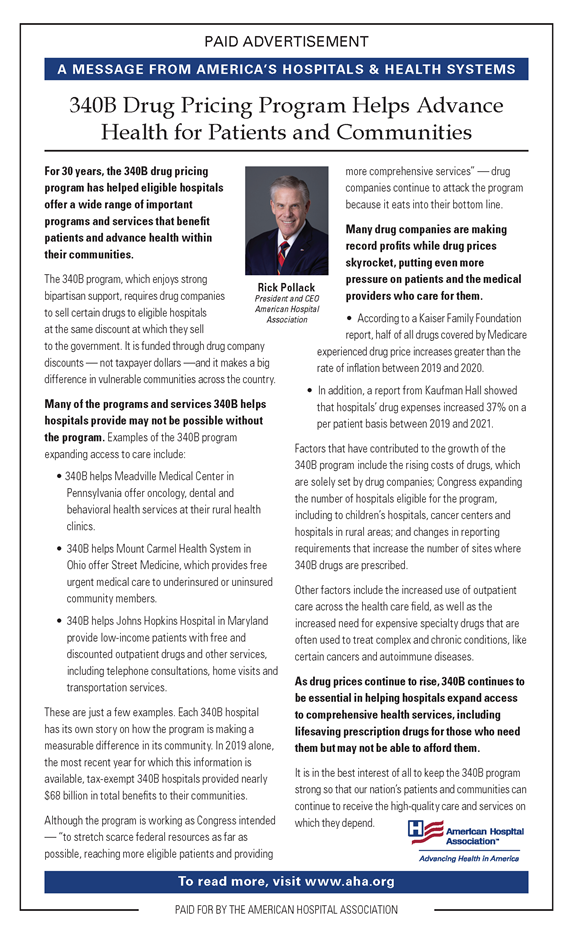AHA Advertorial: 340B Drug Pricing Program Helps Advance Health for Patients and Communities
by Rick Pollack, President and CEO, AHA
A Message from America's Hospitals & Health Systems
As Seen in The Wall Street Journal on January 10
For 30 years, the 340B drug pricing program has helped eligible hospitals offer a wide range of important programs and services that benefit patients and advance health within their communities.
The 340B program, which enjoys strong bipartisan support, requires drug companies to sell certain drugs to eligible hospitals at the same discount at which they sell to the government. It is funded through drug company discounts — not taxpayer dollars —and it makes a big difference in vulnerable communities across the country.
Many of the programs and services 340B helps hospitals provide may not be possible without the program. Examples of the 340B program expanding access to care include:
- 340B helps Meadville Medical Center in Pennsylvania offer oncology, dental and behavioral health services at their rural health clinics.
- 340B helps Mount Carmel Health System in Ohio offer Street Medicine, which provides free urgent medical care to underinsured or uninsured community members.
- 340B helps Johns Hopkins Hospital in Maryland provide low-income patients with free and discounted outpatient drugs and other services, including telephone consultations, home visits and transportation services.
These are just a few examples. Each 340B hospital has its own story on how the program is making a measurable difference in its community. In 2019 alone, the most recent year for which this information is available, tax-exempt 340B hospitals provided nearly $68 billion in total benefits to their communities.
Although the program is working as Congress intended — “to stretch scarce federal resources as far as possible, reaching more eligible patients and providing more comprehensive services” — drug companies continue to attack the program because it eats into their bottom line.
Many drug companies are making record profits while drug prices skyrocket, putting even more pressure on patients and the medical providers who care for them.
- According to a Kaiser Family Foundation report, half of all drugs covered by Medicare experienced drug price increases greater than the rate of inflation between 2019 and 2020.
- In addition, a report from Kaufman Hall showed that hospitals’ drug expenses increased 37% on a per patient basis between 2019 and 2021.
Factors that have contributed to the growth of the 340B program include the rising costs of drugs, which are solely set by drug companies; Congress expanding the number of hospitals eligible for the program, including to children’s hospitals, cancer centers and hospitals in rural areas; and changes in reporting requirements that increase the number of sites where 340B drugs are prescribed.
Other factors include the increased use of outpatient care across the health care field, as well as the increased need for expensive specialty drugs that are often used to treat complex and chronic conditions, like certain cancers and autoimmune diseases.
As drug prices continue to rise, 340B continues to be essential in helping hospitals expand access to comprehensive health services, including lifesaving prescription drugs for those who need them but may not be able to afford them.
It is in the best interest of all to keep the 340B program strong so that our nation’s patients and communities can continue to receive the high-quality care and services on which they depend.


